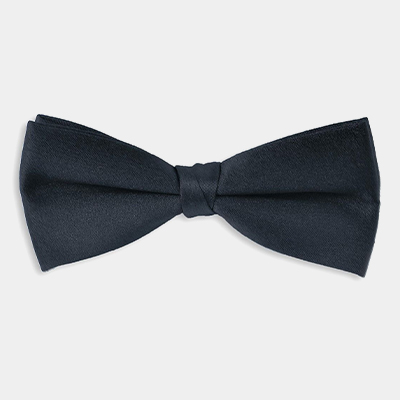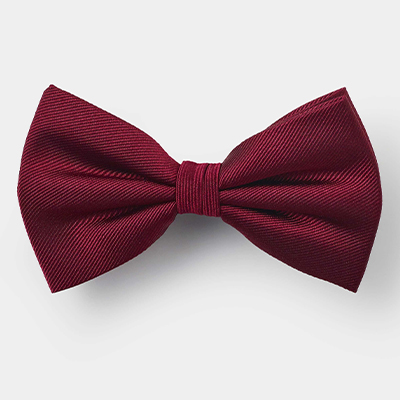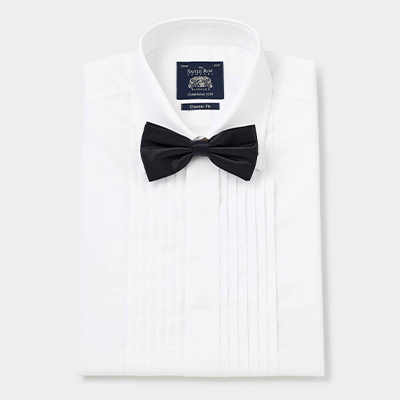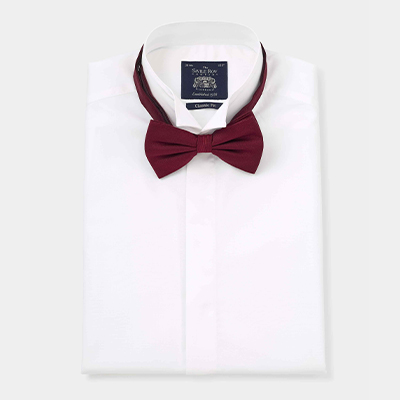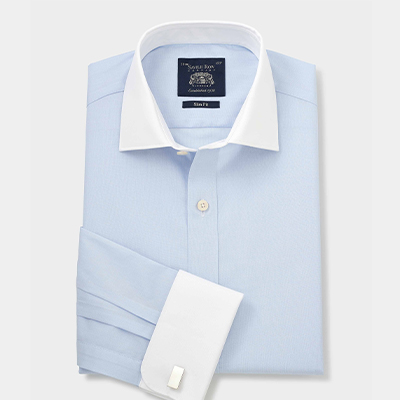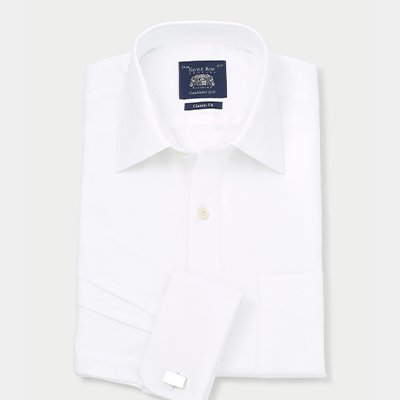From black-tie events and awards evenings to weddings and graduation ceremonies, there are numerous occasions that require a men’s bow tie to be worn. In this comprehensive guide, we'll explore everything you need to know about bow ties—including when you should wear one, what to wear it with and how to tie it.
History of Bow Ties
Bow ties have a rich and storied history that dates back centuries. Originating in the 17th century, bow ties evolved from the cravat, a neckcloth worn by Croatian mercenaries during the Thirty Years' War.
French upper classes later embraced this stylish accessory in the 18th century, and by the 19th century, bow ties became an essential part of formal menswear.
The 20th century witnessed their peak in popularity, with bow ties donned by Hollywood stars and renowned personalities. Despite brief dips in fashion favour, the bow tie's timeless charm has endured, experiencing a resurgence in recent years as a symbol of sophistication and individuality.
Iconic Bow Tie Moments in Pop Culture
Bow ties have left an indelible mark on pop culture, becoming synonymous with certain iconic figures and characters. Think of the suave elegance of James Bond, who often paired a black bow tie with his tuxedo, or the whimsical and colourful bow ties worn by the eccentric Doctor Who.
Musicians like Frank Sinatra and Winston Churchill also contributed to the bow tie's cultural significance. The accessory has transcended its formal roots, making memorable appearances in movies, TV shows and on red carpets, solidifying its status as a timeless and versatile style statement.
When to Wear a Bow Tie
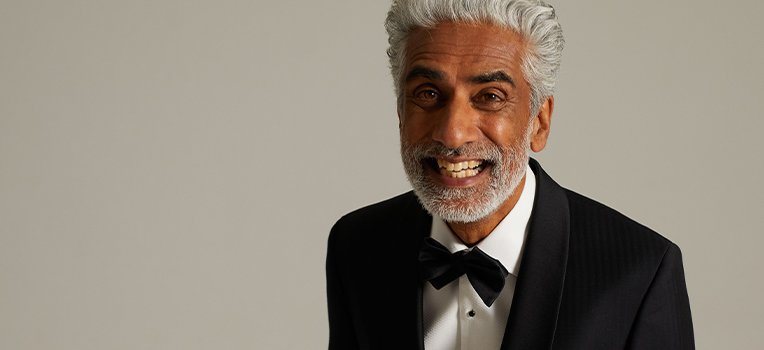
The bow tie, most often associated with formal events, has transcended its traditional boundaries. While it’s still a staple for black-tie affairs, it has also found its way into more casual affairs, such as work events and parties.
Choosing to wear a bow tie is a sartorial statement, signalling confidence, style and a flair for the distinctive. Whether you decide to show yours off at a family wedding or a New Year's Eve celebration, it's the ultimate accessory to elevate your ensemble.
Bow Tie Etiquette
While bow ties exude charm, understanding when and how to wear them is key to mastering bow tie etiquette. Traditionally associated with formal events and black-tie affairs, the bow tie has expanded its domain to include semi-formal and even casual settings.
Proper tying is essential; the self-tie bow tie, though requiring skill to master, adds an authentic touch. Remember, the size of the bow tie should complement the wearer's facial features, and it's crucial to balance the overall ensemble, ensuring the bow tie enhances rather than overwhelms the outfit. Embracing bow tie etiquette adds a touch of finesse and confidence to any occasion.
What to Wear a Bow Tie With
The key to mastering the bow tie lies in pairing it with the right outfit. For formal events, the classic black bow tie perfectly complements a tuxedo and dress shirt impeccably. But for semi-formal occasions, a more colourful version can be easily paired with a well-fitted blazer and chinos.
Remember, the bow tie is a statement piece, so balance is key—let it shine without overshadowing the rest of your attire and consider teaming it with a silk pocket square to complete the look.
Types of Bow Ties
Bow ties come in various styles, each suited to different occasions and personal preferences. The silk self-tie bow tie allows for a customised knot, adding a touch of authenticity to your look, especially for black-tie events.
Pre-tied bow ties, offer greater convenience; they’re great for those new to the bow tie game or simply don’t feel confident enough in tying their own. Whatever type of bow tie you choose, it’s sure to bring a dose of elegance to your ensemble.
What Shirts to Wear With a Bow Tie
Choosing the right shirt to pair with your bow tie is crucial for achieving a polished and cohesive look. The collar style and colour of the shirt play significant roles in complementing the bow tie, creating a harmonious ensemble.
As a general rule of thumb, you must ensure that the bow tie’s width is not beyond the breadth of your shirt collar. This can be easier to accomplish when purchasing a self-tie design that can be adjusted.
In terms of collar options, you have various styles to choose from. These include cutaway, Windsor and spread. Button-down collars can work for smart-casual occasions, while the wing collar shirt is perfect for black or white-tie events.
White shirts are the smartest choice, and essential should you be wearing a black silk bow tie. Having said that, should you be creating a more casual ensemble, you could consider light blue shirts or those with subtle checks or stripes.
How to Tie a Bow Tie
Mastering the art of tying a bow tie may seem daunting at first, but with a bit of practice, you'll soon find it second nature. To help, you can watch the video below or follow the written instructions.
- Start with the collar of your shirt raised and the bow tie lying flat around your neck, with one end slightly longer than the other.
- Cross the longer end over the shorter one, forming a simple X shape.
- Loop the longer end behind the shorter one, bringing it up and over to create a loose knot.
- Pinch the knot with one hand while using the other to fold the shorter end horizontally, creating a bow shape.
- Wrap the longer end around the folded bow, bringing it behind and through the loop near your neck.
- Tighten the knot by pulling both ends simultaneously until the bow is snug, adjusting the size as needed.
- Practice makes perfect, so don't be discouraged if it takes a few attempts to achieve that polished bow tie look.
Final Word
As a symbol of timeless elegance and a nod to tradition, the bow tie has solidified its place in menswear. Whether you're attending a formal event or looking to elevate your everyday style, the bow tie offers a versatile and stylish option for the refined gentleman.
You may wish to experiment with colours, patterns and styles to find the perfect bow tie that complements your individuality. But you should remember that a classic white dress shirt and black silk bow tie is always the most elegant option.
With a bit of confidence and the knowledge of how to tie it just right, you'll undoubtedly make a statement that's both refined and uniquely yours.
FAQs
Can you wear a bow tie to work?
Wearing a bow tie to work depends on the workplace culture and dress code. In more formal or traditional settings, bow ties may be reserved for specific occasions or higher-ranking roles. However, in contemporary and creative workplaces with a relaxed dress code, sporting a bow tie can be a stylish and distinctive choice, adding a touch of individuality to your professional attire. It's essential to gauge the norms of your workplace and choose the appropriate occasions to showcase this classic accessory.
Which collar for a bow tie?
The most suitable collar for a bow tie is the wing collar. This style features small, folded-down collar points that resemble wings, providing an elegant and formal look that complements the bow tie's shape. The wingtip collar is commonly associated with black-tie events and formal occasions, making it the ideal choice when wearing a bow tie with a tuxedo or a formal suit. Additionally, spread collars can also work well with bow ties, offering a slightly less formal but still refined appearance.
Which shirt for a bow tie?
The ideal shirt for a bow tie is one with a collar that complements the formal and distinctive nature of the bow tie. The most traditional choice is a shirt with a wing tip collar. This collar style is specifically designed to showcase the bow tie in formal settings. It's commonly worn with tuxedos or suits for black-tie events. Spread collars are also a suitable option, providing a bit more versatility and a less formal look.

